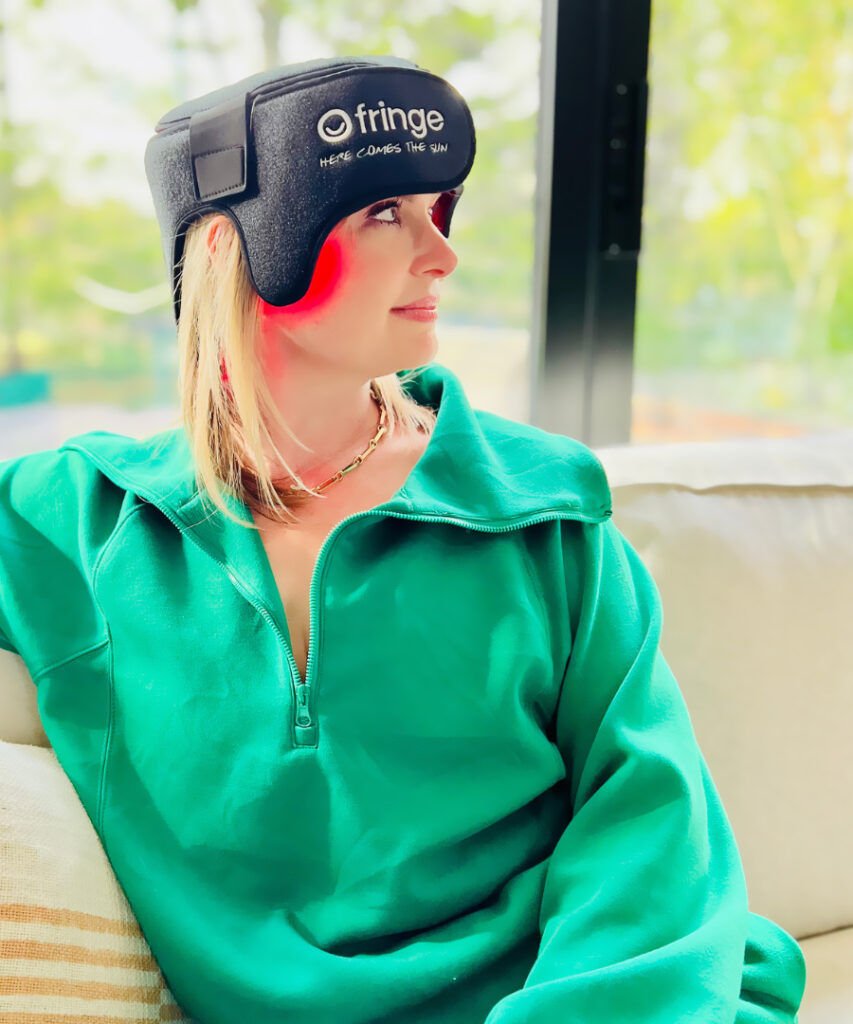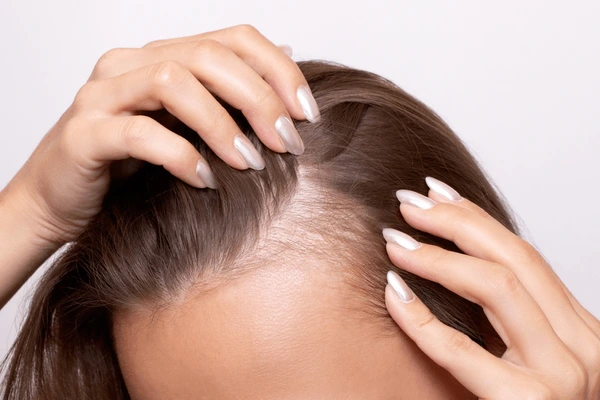Red Light Therapy for Hair Loss: How the Fringe Head Wrap Supports Hair and Brain Health

Introduction: Light as a Hair Growth Ally
Hair loss is an incredibly common concern, affecting millions of men and women worldwide. While genetics, hormones, age, and autoimmune conditions are often to blame, the emotional toll can be just as significant as the physical change. People spend billions of dollars annually on solutions — from prescription drugs to surgical transplants — but one evidence-backed approach is increasingly recognized as a safe, effective, and non-invasive option: Red Light Therapy.
Red Light Therapy (RLT) (also referred to as photobiomodulation, or low level laser light therapy, LLLT) is best known for its ability to support skin health, cognition, and pain relief. It is also well recognized for its ability to stimulate hair growth, improve hair thickness, and reduce shedding. RLT is so effective at supporting hair health that the American Hair Loss Council describes it as an “invaluable addition to [a] hair restoration practice”. The Fringe Red Light Therapy Head Wrap combines red and near-infrared (NIR) light to support both hair and brain health in one simple, wearable device.
How Red Light Therapy Works for Hair Growth
The science behind RLT comes down to how our cells respond to specific wavelengths of light. Red and NIR light penetrate the scalp and are absorbed by cytochrome c oxidase, an enzyme in the mitochondria (the cell’s energy producing “power plants”). This absorption triggers a cascade of benefits:
- Enhanced Energy Production (ATP) – More cellular energy means hair follicle cells can function optimally, supporting robust hair growth.
- Improved Blood Flow – RLT encourages microcirculation, delivering more oxygen and nutrients to hair follicles.
- Reduced Inflammation – Chronic inflammation can damage follicles and slow growth; red and NIR light help calm this response.
- Prolonged Growth Phase (Anagen) – Studies suggest that RLT can help follicles stay longer in the active growth phase.
Multiple clinical trials have shown measurable improvements in hair density, hair diameter, and overall scalp coverage after consistent RLT use.
Androgenetic Alopecia: The Most Common Form of Hair Loss
Androgenetic alopecia (hereditary hair loss) accounts for most hair loss cases in both men and women. It typically presents as gradual thinning and a receding hairline in men, and diffuse thinning along the part in women. Standard treatments include:
- Finasteride – a prescription medication that blocks the conversion of testosterone to DHT, the hormone linked to follicle shrinkage.
- Minoxidil – a topical treatment that helps keep follicles in the growth phase.
While effective for many, these medications have limitations — including potential side effects, the need for indefinite use, and incomplete results.
Red Light Therapy offers a complementary or alternative approach to androgenetic alopecia, with a recently published systematic review concluding that “[RLT] is an effective treatment option” for patients with the condition. Some studies suggest RLT can achieve hair regrowth results comparable to standard treatments and using them together may produce synergistic effects. That means for someone already on a standard hair loss regimen, adding the Fringe Head Wrap could accelerate and enhance results.

Alopecia Areata: Harnessing Anti-Inflammatory Effects
Alopecia areata is an autoimmune condition where the body’s immune system attacks its own hair follicles, causing patchy bald spots. One hallmark of this condition is inflammation around follicles during the growth phase.
Although less well studied, RLT (which has anti-inflammatory effects) may also be a complementary approach to alopecia areata. By reducing inflammation and stimulating follicular activity, RLT may help revive dormant follicles and encourage regrowth in bald patches. Clinical studies on red and near-infrared light for alopecia areata have reported significant increases in hair regrowth compared to untreated areas, although it is important to note that most studies used laser, rather than LED, light.
Why Near-Infrared Light Matters
Most hair growth devices focus exclusively on red light (typically in the 630–680 nm range). While red light is excellent for hair follicle stimulation, near-infrared (NIR) light (810–850 nm) has also been shown to support hair growth – and it penetrates deeper into tissue, affecting not just follicles but also nerves, blood vessels, and even brain tissue.
This deeper penetration means the Fringe Head Wrap offers dual benefits:
1. Hair health – Red and NIR wavelengths energize and protect hair follicles.
2. Cognitive and mood support – Red, and especially NIR, light has been linked to improved brain blood flow, mitochondrial function, and neuroprotection.


The Fringe Red Light Therapy Head Wrap: Designed for Real Life
Unlike bulky helmets or rigid caps, the Fringe Head Wrap is soft, flexible, and wireless, making it comfortable enough to wear while relaxing, working at a desk, or moving around the house. Its design also addresses concerns that often keep people from using light therapy consistently:
- Ease of use – Wrap it around your head, press start and go about your day.
- Ultra-low EMF – Engineered to minimize unnecessary electromagnetic exposure.
- Affordability – Offers professional-grade light therapy without the high price tag of many FDA-cleared devices.
- Dual wavelength – Combines both red and NIR light for a more comprehensive “neck-up” health approach.
What to Expect from Red Light Therapy for Hair Loss
Consistency is everything with RLT. While some users report noticing reduced shedding within the first month, visible regrowth often takes 3–6 months. This is because hair grows in cycles, and follicles need time to complete their current phase before changes become obvious.
A typical at-home protocol might include:
- 3–5 sessions per week (each about 10–20 minutes)
- Clean, dry scalp during treatment for best light penetration
- Combining RLT with a healthy scalp environment — gentle cleansing, avoiding harsh chemicals, and supporting nutrition
Safety Profile
One of RLT’s biggest advantages is its excellent safety record. Unlike UV light, red and near-infrared wavelengths are non-ionizing and do not damage DNA. Side effects are rare and mild, usually limited to temporary scalp warmth or mild redness in sensitive individuals.
That said, as with any therapy, following manufacturer guidelines is important — especially regarding session length and frequency.
Final Thoughts
Red Light Therapy has earned its place as a clinically supported, safe, and easy-to-use option for hair restoration. With the added cognitive benefits of near-infrared light, the Fringe Red Light Therapy Head Wrap delivers more than just cosmetic improvement — it supports total neck-up wellness.
For anyone dealing with hair loss — whether from hereditary causes, autoimmune triggers, or other factors — adding this type of light therapy to your routine could be an invaluable step toward restoring confidence and supporting long-term scalp and brain health.

about the author
Dr. Genevieve Newton, DC, PhD spent close to 20 years as a researcher and educator in the field of nutritional sciences before joining Fringe as its Scientific Director. Gen’s job is to “bring the science” that supports Fringe’s products and education. She is passionate about all things Fringe, and is a deep believer in healing body, mind and spirit using the gifts of the natural world.
The contents in this blog; such as text, content, graphics are intended for educational purposes only. The Content is not intended to substitute for professional medical advice, diagnosis, or treatment. Always seek the advice of your healthcare provider.
